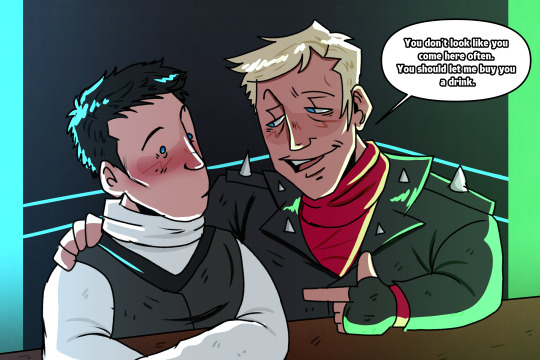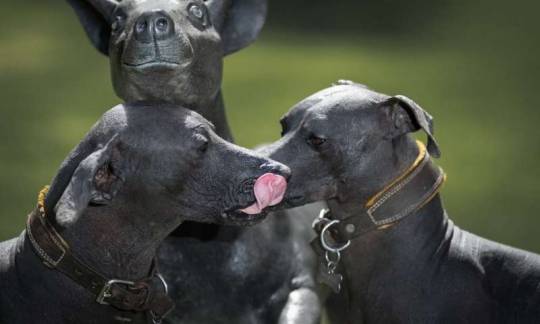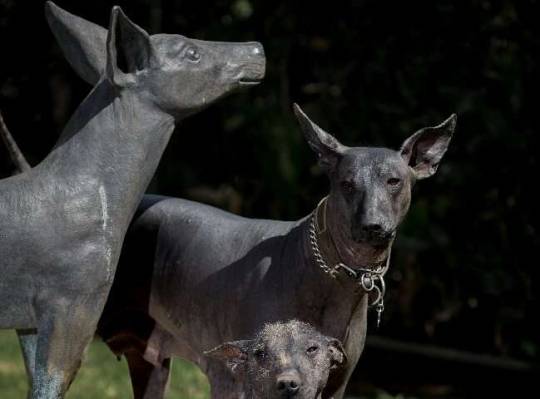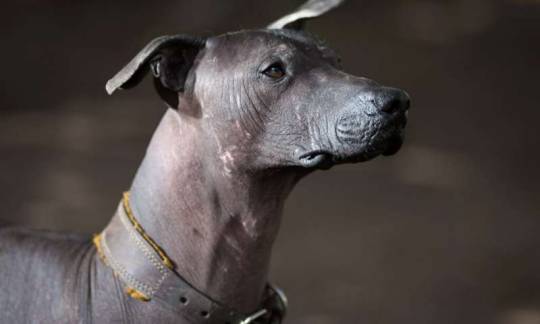#if they had bodies to be buried Historians would look at their skeletons and say
Text


OLD MEN IN LOVE
OLDMENINLOVE
O L D M E N I N L O V E
#the technomancer#Ian Mancer#Connor Mancer#Ship: Integrated Circuits#Fandom: Technomancer#OLD MEN IN LOVE#THEY GOT ME YEARNING#the demi urge to grow old with the man u love#if they had bodies to be buried Historians would look at their skeletons and say#“they were very good friends”#and the ghost of Ian would be offended at the terrible level of Archeology going on rn#they are husbands
16 notes
·
View notes
Text
Some Sir Daniel Fortesque Headcanons
Because this guy is the newest blorbo I’ve been rotating around in my head.
Gonna sprinkle Resurrection in my headcanons because fuck it, I like the Resurrection Pumpkin Witch. She’s fun. Classic Pumpkin Witch still exists in my ideas, but as the Resurrection!Witches’ mom. Packed with more witch-y goodness.
---------------
Neutral Headcanon: Sir Daniel’s job before he was a knight was “oral historian”. In short, yes, he was a bard. With the silly outfit and the lute and everything.
He was also exceptionally well-read, living in surrounding town next to Castle Peregrin and working as a librarian. (which is an anachronism since the printing press wouldn’t be for another 200 years, but hey, Sleeping Village had a library and there’s physical books all over the place; gonna make a bold stab and say that Dan being extremely literate and verbose in his journal didn’t magically spring up from the grave)
The one Non-Sad Headcanon: Sir Daniel and Pumpkin Witch were in a serious relationship that lasted for years. There was even talks that they were going to get married. It was one of those “I’m surprised they hit it off so well, because she certainly didn’t fall for him for his looks” type of silly romances. Just a witch in training and some pumpkin-loving librarian/bard/knight?/wait-he’s-a-knight-now?/okay. Her sister was quoted as saying that he was “as ugly as a horse’s butt” when they were dating.
They met while he was bunking off school to scrump the succulent pumpkins with his fellow schoolmates from the castle town. His words, not mine.

Daniel is a very easy man to please. Like a Harvest Moon bachelor, that man.
---------------------
Sad Headcanon: Right before his death, Sir Daniel Fortesque had his whole life planned out. Once he got older and his wonderful bardly tales of justice and knighthood led him to be knighted by King Peregrin himself, he decided that he was going to use his newly found kingly knight status (which he believed to be mostly ceremonial, even if he made a living out of telling grand tales of battles to a captive audience) to live the life of luxury in the countryside with his cool eventual pumpkin wife and his many eventual children, half of which would have terrible teeth like him.
Even when he heard rumor that he was going to do battle with an evil wizard and his horrible undead army, sure, he was pretty anxious about it (and had the lingering thought “I’m fucked” swirling in his head), but he also knew how stories worked and seemed that he was sure to beat some impossible odds and be allowed to retire a hero’s retirement at the tender age of 25-ish.
All he had to do was just win one battle and he was set for life. Easy, right?


Spoiler alert: They instead found his mangled body in a puddle of his own splattered brain matter.
-------------
Sadder Headcanon: Since his talent was storytelling and weaving grand tales of slaying monsters and surmounting great odds, he was also a very good singer. A lot of his grand epics were also in song form and he’s fantastic at playing the lute. (also has some background with the harp, but that was mostly used in church ceremonies in the castle town)
They buried his lute with him but, as luck would have it, moisture got to it and it was a pile of sad, disintegrated pulp by the time Dan was resurrected.
But hey, give that skeleton a lute. He’ll actually play something nice.
------------------
Saddest Headcanon: The voice he has as a jawless skeleton doesn’t sound like the voice he had when he was alive and, while he won’t say this out loud, he has body dysmorphia over it and is one of the reasons why he doesn’t talk much. His mumbly zombie voice hurts him in a way he can’t put to words. The whole “short words gets the point across better than trying to say an entire sentence” thing is just a bonus.
He slowly starts to get over this over time, but there’s still the lingering thought of “oh dear god, that’s not my voice” whenever he says something.
--------
Bonus:

#Turquoisephoenix's Headcanons#Medievil#Sir Daniel Fortesque#Medievil Resurrection#Pumpkin Witch#(slaps the roof of a skeleton) you can fit so much trauma in this bad boy
18 notes
·
View notes
Note
Where do you think Hephaistion's body was by the end of Alexander's life (Babylon, on his way to Macedon, etc.)? What do you think about the Amphipolis Tomb and its recent link to Hephaistion?
I think Hephaistion was cremated in Babylon, as per Diodoros, et al. I’ve read various attempts to say he wasn’t, based on time required to build the funeral monument, or it was too elaborate—why would Alexander burn something that expensive, etc. Not convinced by these arguments, as they wouldn’t have started on it when he arrived. He no doubt sent word not long after the death, so they’d have had from (probably) early November (by the time news reached Babylon) until sometime in the spring.
As for, “Why burn something that expensive?” Um, have y’all SEEN the amount of wealth Macedonians regularly poured into the ground with their burials? That was their culture. They didn’t build freakin’ huge temples, they built freakin’ expensive TOMBS. And on top of a lot of those tombs, they had cremations, where they burned up (also) a lot of money in grave goods. It was a POTLATCH, meant to honor the dead. You bet Alexander would have built the biggest damn funeral he could imagine for the man he considered his “other self.” Historians need to stop thinking like moderns and think like (ancient) Macedonians.
No source indicates Hephaistion’s body was sent back to Macedon, nor that Alexander intended that. As the new Chilliarch of the empire, he would’ve been stationed in Babylon, so it makes perfect sense for Alexander to hold his funeral there. It’s harder to explain why Alexander would have wanted to send his body (or his ashes, rather) back to Macedonia. He would’ve wanted them near him, in the purported planned capital of his empire. He may (probably did) intend to build a more permanent memorial there, but obviously didn’t live to do so, nor do we hear about it, so we can only suppose.
I have serious qualms about making ANY connection between the Kasta (Amphipolis) Tomb and Hephaistion based on the appearance of an Eta and Phi scratched in a wall (Eph). There’s also an “Anti” there, I believe, the excavator tries to argue means “Antipatros.” (?!)
In any case, the presence of multiple skeletons points to the Kasta Tomb as a family burial. We also have dating issues. The use of blue-colored pebbles in the mosaic suggests a later date than the end of the 4th Century. ALL pebble mosaics from Aigai and Pella dated to the late 4th Century (e.g., very early Hellenistic) do not include blue. They’re nature tones with a more traditional Greek painters’ pallet. Including blue makes me want to down-date that tomb to somewhere in the 3rd century…still well within the range of the use of pebble mosaics.
As for that “mark”—there is absolutely nothing in the historical record stating that he used that as his signature. I would know. I’ve read everything written about him, in all ancient sources. Maybe he did, but there’s nothing to back it up. And there are a *whole* lot of names that start “Eta-Phi” in Greek. I just did an epigraphical study looking at them. Hephaistion is one of the most popular, but far from unique.
Last, that sort of “signature” on something constructed, from pottery to mosaics to statuary…it’s usually a CREATOR’S mark. Like a signature in the corner of a painting. Because Hephaistos was the god of craftsmen, unsurprisingly we find variations on that name (Hephaistodoros, Hephaistos, Hephaistion, Hephaistokles…etc., etc.) among craftsmen. There’s a whole family of potters using Hephaistos from Sinope, spanning a couple hundred years. There are some cases where it might indicate the owner of an object, but those are much smaller objects, like a pot, or a tool, or a caduces, and it appears (usually) in the genitive (Of ___ or ___’s).
In my considered opinion, one of the creators of the Kasta tomb probably had a name that started Eta-phi. That’s all we can safely say, I think.
Were it a cenotaph for Hephaistion, his name would appear OUTSIDE, and there wouldn’t have been a body/bodies in it. (A cenotaph is a memorial that doesn’t contain a body, either because the body was never recovered, or it’s buried elsewhere.) Again, I cannot support arguments that he was never cremated when all our sources suggest he was.
Yet even if we entertain the possibility he wasn’t, it still doesn’t line up to make the Kasta Tomb “his.” Why would what appears to be the “central” figure buried there be a woman in her 60s? (Part of why some wanted to name it Olympias’s Tomb—problems with that too.) The use of Persephone’s abduction is far more often seen in female burials. In fact, I can’t think of a male Macedonian burial with Persephone. Doesn’t mean there isn’t one—especially as new ones periodically pop up—but I can’t think of one. ( @kneelbeforeclefairy? You were just there.)
To make it line up with Hephaistion, too many things have to be “explained away.” I prefer the KISS principle. 😉
If it is a family tomb, as it seems (and as with Lyson and Kallikles), then names might appear inside near niches, but it wouldn’t be an abbreviation. So IMO, the chief excavator is trying really hard to attach her tomb to somebody famous, but using unconvincing evidence.
Given the amount of money poured into it, it was most likely a family tomb for somebody famous, or at least rich, living under the Antipatrids in the 3rd century. I’d go further to say the tomb was initially built for the older woman, then other family members were added to it later.
Who, we may never know at this remove.
That’s the curse of archaeology. Only rarely does what comes out of the ground (convincingly) match up with names in our ancient narratives.
#Hephaistion#Hephaestion#Alexander the Great#Kasta Tomb#Amphipolis Tomb#Hephaistion's death#Olympias#Macedonian funerals#Macedonian Tombs#Macedonian burials#Macedonian religion#asks
24 notes
·
View notes
Link
As Always: text is provided only in the event of access expiration or post deletions from the hosting site. Whenever possible, always read the article at the link.
Note: I've been debating setting up a web store where I sell Folklore Correct Vampire Hunting Kits, but I'm already busy enough. My plate is full. I don’t need goths and former twilight fans emailing me that I’m an “idiot” for not including this, that or the other thing.
I did put one together over a weekend just to illustrate the differences between Hollywood inspired kits and the folk tales. Like... I can tell the maker of the kit was a fan of Bram Stoker-ish vampires or if they preferred Hammer Horror. And neither fandom would do much to actually “kill” a vampire.
PS: no. Gwyneth Paltrow’s Vampire Repellent wont do shit except suck all the money from your bank account.
https://www.mirror.co.uk/news/uk-news/silver-bullets-killing-kits-very-13940409
Silver bullets, killing kits and the very weird history of vampires
Creepy cases packed full of vampire-killing instruments are selling for tens of thousands of pounds
ByMatt Roper
13:16, 6 FEB 2019
A vampire killing kit might not seem like the most obvious item for your gift wish list but it's the latest must-have possession.
It has been claimed the cases of creepy instruments were once used by real life Dracula hunters.
And they don’t come cheap - ‘authentic’ kits dating back to the 17th century can sell for tens of thousands of pounds.
Most of the antique cases include wooden stakes and a mallet - to strike vampires through the heart - as well as a crucifix, rosary and prayer book, and a pistol with silver bullets.
Other items include garlic powder, holy water and vials containing anti-vampire serums.
But while, with a recent new vampire fever taking hold, the kits are experiencing a modern-day renaissance, doubts have been raised about whether they ever existed at all.
Even the Royal Armouries Museum in Leeds recently admitted the vampire killing kit it's had on display since 2012 might not be authentic.
The museum's Keeper of Firearms, Jonathan Ferguson, wrote that after researching vampire slaying “it became clear that kits like our one could not have existed until the era of ‘Hammer’ horror films in the 1950s-70s”.
But he said it still had value as “an invented artefact that reflects our cultural obsession with the vampire.”
Another museum, however, insists their vampire killing kits are 100 per cent genuine.
Ripley’s Believe It or Not! museum claims it owns the world’s largest collection of the kits, of which no two are alike.
The kits contain everything the vampire hunter needs
It claims that, while vampires were described in tales and folklore for thousands of years during the 17th century people were so scared of them that they often took extreme precautions.
A graveyard in Poland, for example, was discovered to have people shackled at the neck.
Then, as Bram Stoker’s Dracula swept Victorian England, vampire fears finally made it out of Europe and travellers toured the hills of Transylvania with grave caution.
The museum’s 30 vampire killing kits include stakes, guns and equipment for making silver bullets.
No two kits at Ripley's are the same
There are also vials of liquid including “Professor Blomberg’s New Serum’, a Victorian sulphuric acid stomach tonic called Elixir of Vitriol, and one simply labelled ‘vampirism’.
Ripley’s, which has museums around the world, claims it has managed to authenticate the age of some of the components, including the firearms.
It says: “Were they sold to witlessly terrified travellers in the forests of Transylvania?
"Were they assembled later by mysterious individuals for purposes unknown? Either way, these kits are real.”
Historians agree, however, that for centuries there was a genuine fear of vampires throughout Europe.
'Vampire' skeleton that was speared after death uncovered in Yorkshire burial site
Often, these legends arose from a misunderstanding of how corpses decompose.
People mistook longer-looking teeth and fingernails for bodies turning into monsters, while the dark “purge fluid” that can leak out of a corpse was seen as evidence it had been drinking blood from the living.
Many blamed vampires for outbreaks of diseases like the plague, and the business of killing them, or preventing the dead from feeding on the living, was deadly serious.
Historical accounts emphasised the need for particular methods and tools, such as stakes to destroy the heart - one of the only ways to permanently kill a vampire - and the use of holy water or garlic to ward off the dead.
In a 1979 tract entitled ‘On The Chewing Dead’ a Protestant theologian wrote that people could stop the dead from leaving the grave and eating people by stuffing soil or a stone into the dead person’s mouth.
Without the ability to chew, the tract claimed, the corpse would die of starvation.
In 2006 archaeologists found evidence of this tactic when they unearthed a 16th-century skull in Venice, Italy, that had been buried among plague victims with a brick in its mouth.
Tales of vampires continued to flourish right up to the end of the 19th century, despite a declaration by Pope Benedict XIV that vampires were “fallacious fictions of human fantasy”.
Many of the cases contained cricifixes and firearms
They were also filled with strange vials filled with potions designed to kill a vampire
In 1892, when neighbours of Mercy Brown, a 19-year-old from Rhode Island who had died of tuberculosis, opened up her grave and found blood in her mouth, they took it to be a sign of vampirism.
Believing she was harming her brother, Edwin, who was sick, they burned Mercy’s heart and mixed the ashes into a potion for him to drink - a common anti-vampire tactic.
The potion was meant to heal him but he died a few months later.
By the 20th century belief in vampires subsided, but the monsters were revived in books, films, and more recently, hugely popular TV series.
And it was during the latest period of fascination with the vampire legend that the first anti-vampire kit emerged, in 1986, when one was put up for sale in the US.
The kit contained a percussion pocket pistol with accessories, a combined cross and stake in wood and ivory, and two silver bullets, and was sold as a genuine 19th century artefact.
In the years that followed other kits began to come to light, and values began to climb as the big auction houses got involved, with some fetching tens of thousands of pounds.
While some claimed they were genuine, made to sell to vampire-fearing western travellers to Transylvania, others insisted that vampire killing kits never existed at all.
In 2004, Sotheby's sold a kit attributed to German Ernst Blomberg and Belgium gunmaker Nicholas Plomdeur for nearly £25,000.
Although the auction house cautioned that "neither the existence of the gunmaker Plomdeur nor that of the gunmaker Plomdeur can be confirmed.
"Also open to question is whether these kits were ever employed successfully in the killing of vampires."
Genuine articles once used to stake the hearts of suspected vampires, or expensive novelties still fooling buyers today? One thing is sure, vampires are still dividing opinions and fomenting beliefs even today.
3 notes
·
View notes
Text
6 Famous Figures, Past and Present, Who Claimed to Have Encountered Ghosts

Being rich, famous, or influential has plenty of perks—but escaping the spirit world's torments isn't necessarily one of them. Here are six prominent individuals, both past and present, who have either claimed or been said to have had close encounters with ghosts.
1. Joan Rivers
Few people—either living or dead—likely would have wanted to mess with Joan Rivers. But when the late comedian purchased a swanky Upper East Side penthouse condo in 1988, she found herself facing a formidable foe: the ghostly niece of financier and banker J.P. Morgan.
Rivers’s new home was a Gilded Age mansion, which was converted into condos in the 1930s. When she tried to renovate her own digs, however, she noticed a peculiar presence: “It was just very strange,” Rivers recounted in a 2009 episode of Celebrity Ghost Stories, according to the New York Post. “The apartment was cold. I could never get any of my electrical things to work correctly.” She also recalled that her pet Yorkshire Terrier refused to enter the room for months, and she saw strange graffiti on the walls.
When the building’s elevator operator heard about the strange occurrences, he reportedly said, “I guess Mrs. Spencer is back.” Instead of going head-to-head with the specter—who reportedly still thought of herself as "the grande dame of the building," according to Rivers—the comedian called in a New Orleans voodoo priestess to cleanse the home of spirits, and Rivers reported that her dog finally came into the apartment. But the hauntings soon returned—until Rivers made nice with the ghost by hanging a portrait of her in the building lobby and leaving flowers out for her.
In 2015, less than a year after Rivers's death, a Saudi prince purchased the penthouse for $28 million. According to reports, he disliked her decorating style and planned to gut-renovate the apartment. No word, however, on whether he’s also personally experienced the ire of Mrs. Spencer.
2. King George IV
Raynham Hall is a palatial estate in Norfolk, England with a spooky backstory: It’s reportedly haunted by a ghost known as the “Brown Lady of Raynham Hall”—and it's said that King George IV once saw the spirit with his own eyes.
The Brown Lady (who gets her name from her brown brocade dress) became world-famous in 1936 after photographers from Country Life magazine allegedly took a photo of her floating down the stairs in Raynham Hall. She’s believed to be the spirit of Dorothy Walpole, the sister of Great Britain’s first Prime Minister, Robert Walpole.
An important noble family called the Townshends built Raynham Hall in 1620, and a member of the clan—Charles Townshend, an 18th century British secretary of state—married Dorothy Walpole. The marriage was rumored to have been a bad one, and in 1726 Dorothy died around the age of 40, reportedly from smallpox. (One alternate tale says that Townshend pushed her down the estate’s grand staircase and she broke her neck; another claims she died of a broken heart.)
Dorothy’s spirit lingered, and Norfolk legend says that when King George IV was the young Prince of Wales, he slept in the estate’s State Bedroom and woke to see “a little lady all dressed in brown, with disheveled hair and a face of ashy paleness.” The future king left Raynham Hall immediately, and swore he would never spend another hour in the cursed house again.
3. Sir Arthur Conan Doyle
At the peak of Sir Arthur Conan Doyle's fame, the Sherlock Holmes author became obsessed with the paranormal. He believed in ghosts, wrote books about spiritualism and fairies, and attended séances. Sir Arthur didn’t believe he possessed supernatural powers himself, but in his 1930 book The Edge of the Unknown, he described several chance brushes he had with spirits.
In one anecdote, Sir Arthur described waking up “with the clear consciousness that there was someone in the room, and that the presence was not of this world.” His body was paralyzed, but he could still hear footsteps echoing across the room. Then, Sir Arthur said he sensed a presence leaning over him, and heard them whisper, “Doyle, I come to tell you that I am sorry.” Moments later, the mysterious visitor vanished, and Sir Arthur’s body unfroze.
Sir Arthur’s wife slept through the entire thing, but Doyle was convinced that the experience wasn’t a dream. He believed the ghost to be “a certain individual to whom I had tried to give psychic consolation when he was bereaved.” The man had turned down Doyle’s offer “with some contempt, and died himself shortly afterwards. It may well be that he wished to express regret,” Doyle wrote. As for his sleep paralysis, the author believed that the spirit needed to borrow power from a living person to appear in the physical world, and it had chosen him.
4. Sting
Fans of Sting know he’s no stranger to singing about ghosts. But in a few interviews, the ex-Police frontman claimed to have seen one, too.
At the time of his sighting, Sting had young children and owned a 16th century English manor house. One night, the musician awoke with a jolt at 3 a.m. He “looked into the corner of the room and thought I saw [my wife] Trudie standing there with a child—our child—in her arms, staring at me,” the musician recalled in a 2009 interview with BBC Radio 2.
Sting then reached over and noticed that Trudie was still in bed. He “suddenly got this terrible chill,” he said. “And she woke up and said 'Gosh, who is that?' and she saw this woman and a child in the corner of the room.''
The ghostly figure disappeared, but Sting’s spooky encounters were far from over: “A lot of things happened in that house, a lot of flying objects and voices and strange, strange things happened,” he said. “When you live in old houses, you get this energy there.”
5. Athenodorus Cananites
Historians remember Roman magistrate and writer Pliny the Younger for his dramatic, first-hand account of Mount Vesuvius’s eruption in 79 CE, but he could also tell a good ghost story. Around 100 CE, the scribe wrote a letter recounting the time the Greek Stoic philosopher Athenodorus Cananites stayed in a haunted house.
“There was in Athens a house, large and spacious, which had a bad reputation as though it was filled with pestilence,” the tale began. “In the dead of night, a noise was frequently heard resembling the clashing of iron which, if you listened carefully, sounded like the rattling of chains. The noise would seem to be a distance away, but it would start coming closer … and closer … and closer. Immediately after this, a specter would appear in the form of an old man, emaciated and squalid, with bristling hair and a long beard, and rattling the chains on his hands and feet as he moved.”
The home was eventually abandoned, and it remained empty until Athenodorus came to town. He considered buying the property, but was suspicious about its low price. The philosopher would soon learn that the house was haunted—but surprisingly, this made him want to buy it even more.
Athenodorus purchased the home, moved in, and stayed up late working, hoping to run into the ghost. Sure enough, he eventually heard the rattle of chains, looked up, and saw the old man’s spirit standing in front of him.
The philosopher pretended to ignore the ghost, but the impatient ghoul beckoned toward Athenodorus, motioning for him to come outside. He did, and the old man vanished—but the next day, Athenodorus ordered for the spot he disappeared on to be dug up. There, he found the ancient skeleton of a man clad in chains.
The bones were given a proper burial, and the ghost never haunted Athenodorus—or any other citizen of Athens—again.
6. Dan Aykroyd
Dan Aykroyd’s experiences with spirits aren’t limited to Ghostbusters. In a 2013 interview with Esquire, he claimed to have once lived in a Hollywood abode that was haunted by singer Cass Elliot, from American folk rock group The Mamas & the Papas, along with the ghost of a man buried under a hillside next to the house.
“I had several experiences,” Aykroyd recalled. “I saw things moving around on our counter, and doors opening and closing. The staff also had experiences, direct contact in terms of tactile touching, and then turning around and there's no one there.”
One day, Aykroyd claimed, one of the two ghosts crawled in bed with him while he was taking a nap. He woke up “in a trance," he said, and noticed that the bedroom’s previously closed door was ajar. Then, the actor spotted “a depression in the mattress, like somebody was getting in there,” he said. Not one to be afraid of no ghosts, Aykroyd decided to snuggle the spirit instead of screaming for help.
[Kirstin Fawcet, Mental Floss]
43 notes
·
View notes
Text
Revered by Aztecs, Mexican hairless dog in style again in hipster era
https://sciencespies.com/biology/revered-by-aztecs-mexican-hairless-dog-in-style-again-in-hipster-era/
Revered by Aztecs, Mexican hairless dog in style again in hipster era


Xoloitzcuintles (ancient Mexican hairless dogs) play next to a Xoloitzcuintle statue in the garden of the Dolores Olmedo Museum in Mexico City
At a stately museum in Mexico City, priceless paintings by Frida Kahlo and Diego Rivera share pride of place with an unruly pack of hairless black dogs: Mexico’s prized xoloitzcuintle.
The 13 dogs who reside on the leafy grounds of the Museo Dolores Olmedo are the direct descendants of ones that belonged to Kahlo and Rivera, whose searingly intimate portraits (her) and sprawling murals (him) made them the towering power couple of 20th-century Mexican art.
Kahlo and Rivera were proud of their Mexican heritage, which made the xoloitzcuintle—a tongue-twister pronounced something like show-low-eats-QUEEN-t-lay—an obvious choice for the family dog.
They even put their dogs in their paintings—some of them now on display at the museum where their great-great-grandpuppies reside.
“Xolos,” as they are known for short, are a quintessentially Mexican dog.
The ancient species goes back 7,000 years and was first domesticated around 5,500 years ago.
The Aztecs named the dog for the god of death, Xolotl, combined with “itzcuintli,” or dog. They had themselves buried with xolos so the dogs could guide them to Mictlan, the underworld where they believed life continued after death.
The dogs have gone in and out of style since the Spanish conquistadors arrived in 1519 and toppled the Aztecs.

Xoloitzcuintles have gone in and out of style since the Spanish conquistadors arrived in Mexico in 1519 and toppled the Aztecs
But five centuries later, they are rolling around in the glory of a renaissance, beloved by the hipster set in trendy neighborhoods across Mexico City and the country.
“The xoloitzcuintle has not just served as an inspiration and model to Mexican artists, it has also joined the list of icons that represent Mexican identity, such as Day of the Dead skeletons, Frida Kahlo and the Aztec calendar,” said Maria Olvido Moreno, an art historian at Mexico’s largest university, UNAM.
Doggy survivors
Xolos lack hair—though some do have a mohawk on top of their head—because of a genetic mutation that makes their organisms unable to read the DNA for fur, according to experts.
They are also known for missing pre-molar teeth, which leads to another characteristic look: their pink tongues can often be seen lolling out of their mouths.
Additionally, their bodies are particularly warm. In ancient times, people with rheumatism or asthma would press the dogs to their bodies as treatment.
By the time, Mexico launched its war for independence from Spain in 1810, the xolo was on the brink of extinction.
The Spaniards had spurned the animals as a symbol of what they considered pagan beliefs, and even killed and ate them.

Xoloitzcuintles were able to survive largely thanks to the mountains in southern Mexico, where they lived in the wild before being re-domesticated by indigenous farmers
But xolos were able to survive largely thanks to the mountains of southern Mexico, a remote region where they lived in the wild before being re-domesticated by indigenous peasant farmers.
But the dogs’ big cultural comeback came after the Mexican Revolution of 1910.
The revolution ousted dictator Porfirio Diaz and his Europhile ruling class. The new Mexican cultural elite, including Kahlo and Rivera, set about reclaiming long-stigmatized symbols of indigenous identity—not least the xolo.
Kahlo (1907-1954) and Rivera (1886-1957) can be seen proudly posing with and cuddling their xolos in black-and-white photos from the mid-20th century.
Rivera gave a pair of them to their friend Dolores Olmedo, a businesswoman, philanthropist and art collector.
Those are the ancestors of the dogs that now roam the grounds of the museum Olmedo established in her former home, which hosts the world’s largest collection of Kahlo and Rivera paintings.
There is a statue in the dogs’ honor on the museum grounds, and a professional caretaker just for them.
“To us, these dogs are living works of art, just like Rivera’s and Kahlo’s paintings,” said curator Josefina Garcia.

Xolo lovers say the dogs’ distinct personality “really sets them apart”
‘Coco’ and rock stars
Xolos have become cool once again in the 21st century—the dog of choice for 20- and 30-somethings proud to embrace their Mexican heritage.
They have had articles devoted to them in such places as the style pages of The New York Times, were declared an official “icon of Mexico City” in 2016 and are the preferred pooch for residents like Ruben Albarran, frontman for famed rock band Cafe Tacvba.
“They have this link to Mexican culture that I love,” Albarran told AFP.
A xolo also featured prominently in Disney-Pixar’s 2017 movie “Coco”, which won the Oscar for best animated film.
“Xolos are a good choice for people who are interested in Mexican identity. And a hairless dog makes an excellent pet for fast-moving Mexico City. They can live in an apartment and are easy to care for,” said Raul Valadez, an expert at UNAM’s paleozoology lab.
Proud xolo owner Oscar Gamas, a 43-year-old audio designer in Mexico City, said he, like many people, first got interested in the dogs for their “symbolism.”
But then he fell in love with his dog Deck’s reserved yet fiercely loyal and protective personality.
“When you live with one, you discover they have a personality that really sets them apart,” he said.
Explore further
Asian origins of native American dogs confirmed
© 2019 AFP
Citation:
Revered by Aztecs, Mexican hairless dog in style again in hipster era (2019, December 10)
retrieved 10 December 2019
from https://phys.org/news/2019-12-revered-aztecs-mexican-hairless-dog.html
This document is subject to copyright. Apart from any fair dealing for the purpose of private study or research, no
part may be reproduced without the written permission. The content is provided for information purposes only.
#Biology
0 notes